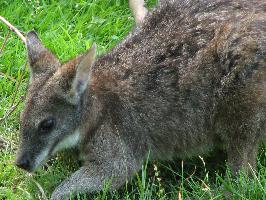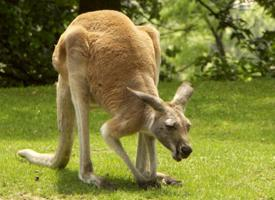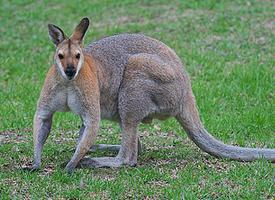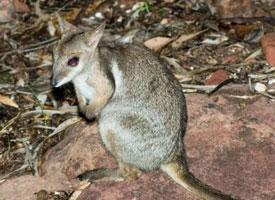
Váhy a míry
| Délka | od 45 do 53 cm |
|---|---|
| Hmotnost | od 3,2 do 6 kg |
| Délka ocasu | od 45 do 53 cm |
Stav ohrožení
| Ohrožen |
Popis zvířete
The Parma wallaby (Notamacropus parma) is a fascinating and somewhat elusive marsupial, indigenous to Eastern Australia. Initially believed to be extinct around the early 20th century, this species was remarkably rediscovered in the 1960s, sparking considerable interest and research into its habits, habitat, and conservation status. This small to medium-sized wallaby is an integral part of Australia's rich biodiversity and plays a significant role in its ecosystem.Physically, the Parma wallaby exhibits a compact and robust body structure, with a distinct, dense fur coat that varies from dark grey to brown, with a noticeably lighter underbelly, often cream or grey in color. They possess a long, powerful tail that aids in balance and movement, and strong hind legs designed for hopping - a characteristic mode of locomotion for wallabies. The Parma wallaby's small, rounded ears and sharp, alert eyes give it a cautious demeanor, reflective of its shy and nocturnal nature.
Adult Parma wallabies are relatively small compared to other wallaby species, with males typically larger than females. On average, they weigh between 4 to 6 kilograms (8.8 to 13.2 pounds) and have a body length of approximately 45 to 55 centimeters (17.7 to 21.7 inches), with their tail adding an additional 40 to 50 centimeters (15.7 to 19.7 inches) to their length.
The Parma wallaby prefers dense, temperate, and subtropical forests, often with a thick underbrush that provides ample cover from predators. This habitat preference makes them difficult to spot in the wild. They are primarily solitary animals, with individuals maintaining their own home ranges that overlap only minimally with others. These wallabies are herbivorous, feeding mainly at night on a variety of grasses, herbs, and leaves, which they forage with their keen sense of smell.
Reproduction in the Parma wallaby is similar to other macropods, with females capable of giving birth to a single joey after a gestation period of about 35 days. The newborn is extremely underdeveloped and crawls into its mother's pouch to continue its development, where it will stay for up to seven months before beginning to explore the outside world. Despite their initial vulnerability, joeys grow rapidly, and females exhibit remarkable reproductive efficiency through embryonic diapause, the ability to delay the development of a new embryo until the current joey has left the pouch.
Conservation efforts for the Parma wallaby have become increasingly important as their natural habitats face threats from human encroachment, land clearing for agriculture, and predation by introduced species such as foxes and cats. Though their population numbers have improved since their rediscovery, the Parma wallaby is still classified as Near Threatened, and continued conservation measures are essential to ensure their survival.
In summary, the Parma wallaby is a unique and resilient species, overcoming challenges of presumed extinction to continue thriving in its natural habitat. With ongoing conservation efforts, it is hoped that this intriguing marsupial will remain a part of Australia's diverse ecosystem for generations to come.
Podobná zvířata
Nové fotografie zvířat
Top 10 zvířat
- Chinese water dragon (Physignathus cocincinus)
- Galápagos tortoise (Geochelone nigra complex)
- Dolphin gull (Leucophaeus scoresbii)
- Japanese macaque (Macaca fuscata)
- Colombian red howler (Alouatta seniculus)
- Sea urchins (Echinoidea)
- Moustached guenon (Cercopithecus cephus)
- Diana monkey (Cercopithecus diana)
- Common reed warbler (Acrocephalus scirpaceus)
- Common house mosquito (Culex pipiens)


